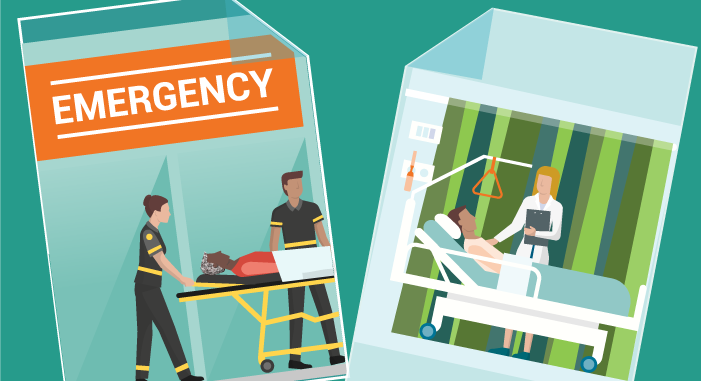GEAR Publications & Manuscripts
Editorial: Adapting Emergency Care for Persons Living With Dementia
Results of the Geriatric Emergency Care Applied Research Network Scoping Review and Consensus Conference
Christopher R. Carpenter MD, MSc, Scott M. Dresden MD, MSc, Manish N. Shah MD, MPH, Ula Hwang MD, MPH
Pages 1286-1287 | August 2022 | https://doi.org/10.1016/j.jamda.2022.05.016
“Altered mental status” in older adults is one common syndromic presentation to the ED, one that includes patients with both delirium and dementia. Historically dementia among ED patients has not been studied to the same degree as delirium. Despite this lack of attention, persons living with dementia (PLWD) are potentially at greater risk for adverse events when accessing emergency care. Unrecognized cognitive impairment can lead to substandard care, safety risks, and worse outcomes for older patients. Some research indicates an increased risk of ED revisits associated with dementia, whereas other studies show no such association.3,4 Similarly, community-dwelling older adults with dementia have higher average expenditures for hospital and ED services, whereas long-term care facility residents have lower expenditures.5 Some of the variability in observed outcomes is likely due to the reality that the spectrum of dementia severity in ED settings is unmeasured, as are the association of social determinants of health and health care disparities amid PLWD in the acute care setting. Nonetheless, symptom severity is associated with ED visit rates and the presence of dementia can alter emergency medicine’s approach to and accuracy of common presentation.6
The United States National Plan to Address Alzheimer’s Diseases includes multiple recommendations pertinent to ED care of PLWD. For example, milestones include credentialing of the health care workforce (including emergency medicine) to deliver dementia-specific care and including mandatory education of ED professionals as a condition of federal payment for services, raising transdisciplinary awareness of the importance of early detection of cognitive impairment, developing quality measures aligned with patient-centered outcomes, and collating existing evidence to identify gaps in knowledge and practice for alternative acute care models for PLWD.7 The National Plan also targets a reduction in avoidable ED use by PLWD.
This issue of the Journal of the Medical Directors Association includes 4 articles from the Geriatric Emergency Care Applied Research 2.0–Advancing Dementia Care (GEAR 2.0-ADC) Network that identify multistakeholders’ research priorities for the emergency department recognition of cognitive impairment, care transitions of patients with cognitive impairment, communication strategies for PLWD, and efficacious management of PLWD while in the ED.8, 9, 10, 11 Funded by the National Institute on Aging (NIA), GEAR 2.0-ADC engages PLWD, their care partners, social workers, geriatricians, neuropsychologists, pharmacists, nursing, and emergency medicine physicians to identify essential research questions and subsequently provide pilot funding (in partnership with the Emergency Medicine Foundation and West Health Institute) and infrastructure support to begin answering those unknowns.12 GEAR 2.0-ADC’s priorities provide a patient-centered foundation on which investigators can design research proposals, while clinicians can build protocols based on contemporary knowledge. The GEAR 2.0-ADC effort is not the first attempt to identify emergency medicine research priorities around an aging population, but it is the first to focus on and partner with PLWD and their care partners.13 Several cross-cutting themes emerged from these 4 manuscripts that are worth highlighting.
Limited Quantity of Dementia Care Research in Emergency Department Settings
Inadequate Reporting Around Diversity, Equity, and Inclusion
Balancing Inspiration With Pragmatism
References
- Hwang, U.; Shah, M.N.; Han, J.H.; Carpenter, C.R.; Siu, A.L.; Adams, J.G. Transforming emergency care for older adults. Health Aff. 2013; 32: 2116-2121
- Southerland, L.T.; Lo, A.X.; Biese, K.;et al.Concepts in practice: geriatric emergency departments. Ann Emerg Med. 2020; 75: 162-170
- Amjad, H.; Samus, Q.M.; Huang, J.; et al.Acute care utilization risk among older adults living undiagnosed or unaware of dementia.J Am Geriatr Soc. 2022; 70: 470-480
- Kent, T.; Lesser, A.; Israni, J.; Hwang, U.; Carpenter, C.R.; Ko K.J.30-day emergency department revisit rates among older adults with documented dementia. J Am Geriatr Soc. 2019; 67: 2254-2259
- Daras, L.C.; Fent, Z.; Wiener, J.M.; Kaganova, Y.Medicare expenditures associated with hospital and emergency department use among beneficiaries with dementia. Inquiry. 2017; 54 (46958017696757)
- Hunt, L.J.; Coombs, L.A.; Stephens, C.E.Emergency department use by community-dwelling individuals with dementia in the United States: an integrative review. J Gerontol Nurs. 2018; 44: 23-30
- Borson, S.; Boustani, M.A.; Buckwalter, K.C.; et al. Alzheimer’s Association National Plan Care and Support Milestone WorkgroupReport on milestones for care and support under the U.S. national plan to address Alzheimer’s disease. Alzheimers Dement. 2016; 12: 334-369
- Nowroozpoor, A.; Dussetschleger, J.; Perry, W.; et al.Detecting cognitive impairment and dementia in the emergency department: a scoping review. J Am Med Dir Assoc. 2022; 23 (1314.31-1314-e86)
- Dresden, S.M.; Taylor, Z.; Serina, P.; et al.Optimal emergency department care practices for persons living with dementia: a scoping review. J Am Med Dir Assoc. 2022; 23 (1314.e1-1314.e29)
- Carpenter, C.R.; Leggett, J.; Bellolio, F.; et al.Emergency department communication in persons living with dementia & care partners: a scoping review. J Am Med Dir Assoc. 2022; 23 (1313.e15-131.e49)
- Gettel, C.J.; Falvey, J.R.; Gifford, A.; et al.Emergency department care transitions for patients with cognitive impairment: a scoping review. J Am Med Dir Assoc. 2022; 23 (1313.e1-1313.e13)
- Hwang, U.; Carpenter, C.R.; Dresden, S.; et al.The Geriatric Emergency care Applied Research (GEAR) Network approach: advancing stakeholder consensus and research priorities in geriatrics and dementia care in the emergency department. BMC Geriatr. 2022; 12: e060974
- Carpenter, C.R.; Heard, K.; Wilber, S.T.; et al.Research priorities for high-quality geriatric emergency care: medication management, screening, and prevention and functional assessment. Acad Emerg Med. 2011; 18: 644-654
- Prusaczyk, B.; Cherney, S.M.; Carpenter, C.R.; DuBois, J.M.Informed consent to research with cognitively impaired adults: transdisciplinary challenges and opportunities. Clin Gerontol. 2017; 40: 63-73
- Carpenter C.R. and Malone M.L.Avoiding therapeutic nihilism from complex geriatric intervention “negative” trials: STRIDE lessons. J Am Geriatr Soc. 2020; 68: 2752-2756
- Carpenter, C.R.; Hammouda ,N.; Linton, E.A.; et al.Delirium prevention, detection, and treatment in emergency medicine settings: a Geriatric Emergency Care Applied Research (GEAR) Network scoping review and consensus statement. Acad Emerg Med. 2021; 28: 19-35
- Rosen, T.; Shah, M.; Lundebjerg, N.E.; et al.Impact of Jahnigen/GEMSSTAR scholarships on careers of recipients in emergency medicine and on development of geriatric emergency medicine. Acad Emerg Med. 2018; 25: 911-920
- Lundebjerg, N.E. and Medina-Walpole A.M.Future forward: AGS initiative addressing intersection of structural racism and ageism in health care. J Am Geriatr Soc. 2021; 69: 892-895
- Hunold, K.M.; Goldberg, E.M.; Caterino, J.M.; et al.Inclusion of older adults in emergency department clinical research: strategies to achieve a critical goal. Acad Emerg Med. 2022; 29: 376-383
- Chary, A.N.; Castilla-Ojo, N.; Joshi, C.; et al.Evaluating older adults with cognitive dysfunction: a qualitative study with emergency clinicians. J Am Geriatr Soc. 2022; 70: 341-351
- Shih, R.D.; Carpenter, C.R.; Tolia, V.; Binder, E.F.; Ouslander, J.G.Balancing vision with pragmatism: The geriatric emergency department guidelines-realistic expectations from emergency medicine and geriatric medicine. J Am Geriatr Soc. 2022; 70: 1368-1373
- Southerland, L.T.; Hunold, K.M.; Van Fossen, J.; et al.An implementation science approach to geriatric screening in an emergency department. J Am Geriatr Soc. 2022; 70: 178-187
- van Oppen, J.D.; Coats, T.J.; Conroy, S.P.; et al.What matters most in acute care: an interview study with older people living with frailty. BMC Geriatr. 2022; 22: 156
- Mooijaart, S.P.; Carpenter, C.R.; Conroy, S.P.Geriatric emergency medicine—a model for frailty friendly healthcare. Age Ageing. 2022; 51: afab280
- Carpenter, C.R.; McFarland, F.; Avidan M.; et al. Impact of cognitive impairment across specialties: summary of a report from the U13 conference series. J Am Geriatr Soc. 2019; 67: 2011-2017
Article Info
Footnotes
Research reported in this publication received support from the National Institute of Aging of the National Institute of Health under Award Numbers R21/R33AG058926 and R61/R33 AG069822 . The content is solely the responsibility of the authors and does not represent the official views of the National Institutes of Health. The authors declare no conflicts of interest.Identification
DOI: https://doi.org/10.1016/j.jamda.2022.05.016Copyright
GEAR 2.0 Scoping Reviews
Emergency Department Care Transitions for Patients With Cognitive Impairment
This scoping review examines the literature on care transition interventions for patients with cognitive impairment receiving ED care and what measures of quality transitions are important for older adults with impaired cognition and their care partners
Read MoreOptimal Emergency Department Care Practices for Persons Living With Dementia
This scoping review demonstrates the state of research on ED care practices for PLWDs. This review demonstrates that studies of components of ED care and emergency care needs for PLWDs are wide ranging with little depth on any topic.
Read MoreEmergency Department Communication in Persons Living With Dementia and Care Partners
Communication factors that influence satisfaction with the hospital experience for PLWD included valuing of the person through staff actions, interactions, and person-centered care; activities of empowerment; and interactions of the environment with patient well-being (physical environment, social and organizational). Robust communication between hospital staff, PLWD and their care partners improves the hospital experience.
Read MoreDetecting Cognitive Impairment and Dementia in the Emergency Department
Over the last 2 decades, there have been multiple studies evaluating ED detection of cognitive impairment specifically focused on dementia. Our scoping review identified more than 45 manuscripts addressing accuracy of detection of cognitive impairment or dementia, 66 addressing pragmatic and practical ways for this detection, and 21 manuscripts overlapping in both.
Read More



